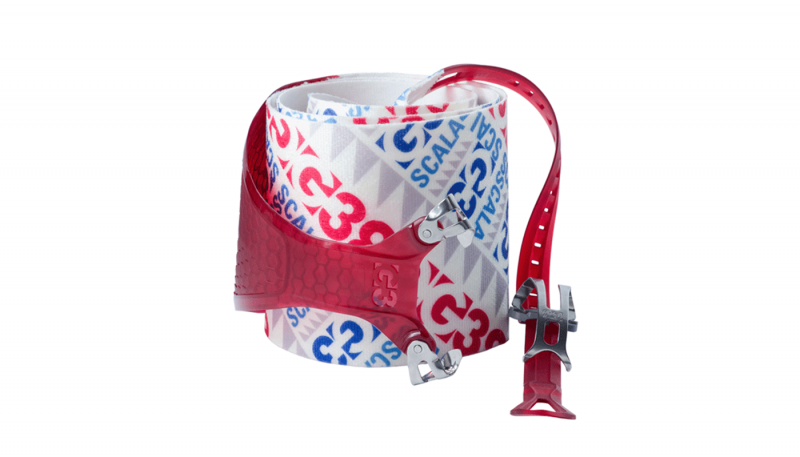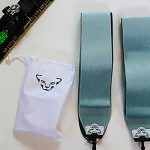Home » Gear Reviews » Ski & Snow » Climbing Skins » G3 SCALA Climbing Skins
G3 SCALA Climbing Skins Review
June 27, 2018





















 92
92 The Good
- Pack down to a super slim size
- Light
- Easy to use tail & tip clips
The Bad
- Plush sticks to skin glue
- Snow can creep under tip
G3’s innovative approach to climbing skin design has enabled them to solve a few key issues, namely, snow creep between the skin and ski at the tip and the difficulty of separating skins after glue-on-glue storage. Their new SCALA skins use a fish scaled Urethane Hybrid Tip Connector which replaces heavier climbing skin plush at the tip of the skins. This not only improves the skin’s glide on snow but does so without impeding grip. It also prevents snow from delaminating the skin from the ski due to snow pushing its way between the two. Skin storage is also made that much easier since we found we can fold the skin plush around this rigid urethane so that the glue comes in contact with the plush and not other skin glue. This also makes unfolding and separation of the glue from the plush super easy. Though this method does reduce the stickiness of the skin to the ski for future use.
Glide to Grip Ratio
Climbing skin plush is made up of either mohair or nylon fibres, with mohair providing better glide characteristics, and nylon better grip on snow. Nylon plush is more durable over the long term and is more hydrophobic than mohair so it will not absorb as much moisture over the ski day. For these reasons, G3 chose to combine both mohair and nylon for the plush of their SCALA skins. They used a 70% mohair and 30% nylon combination to provide slightly more glide than grip with added durability.
Attachments
G3 has always had some of the best-designed climbing skin attachment mechanisms in the industry and those found on the SCALA’s are no exception. They use a simplified tip connector that is made up of two independent clips which have the ability to swivel, making them adaptable to any ski width. On the tails are G3’s tried and true adjustable system that has a rubber strap (like most other skins) along with a metal cam that is connected to a plastic adjuster. This design allows users to lengthen or shorten the position of the cam over a 16cm span which is ideal for skiers with multiple skis of varying lengths. Both the tip and tail connectors are easy to use and won’t slow transition time.
Glue Quality
G3’s glue formula is naturally a secret, so it’s not known specifically what it contains, however it does work well. In all of the testing, there was never any issues with the glue failing and the skins coming off the skis. There was also no issue separating the skins after they had been stored since the glue is only in contact with the plush of the skin and not more glue. This is a huge convenience for any skier as separating climbing skins can be one of the most difficult and frustrating things about backcountry skiing.
Climbing skins typically fail when the temperature drops significantly, however, this was not the case with the SCALAs. I was impressed that I didn’t even have to keep the SCALA’s inside my jacket to ensure they stayed warm. If I did have to at any point the rigid vertical shape of them would facilitate this well.
Weight
G3’s SCALA climbing skins fall in the middle of the pack when it comes to weight. At 25 ounces they are neither the heaviest nor lightest skins on the market. They’re 8.1 ounces lighter than their popular Alpinist skins, which is a huge improvement since lighter is always better when it comes to backcountry skiing gear. Most of this weight savings come from the Urethane Hybrid Tip Connector as this material weighs less than the traditional plush material which is used for the remainder of the skins. While weight is a factor to consider for climbing skins, performance and ease of use is still far more important.
Ease of Use
The most difficult part of using any climbing skin is their separating prior to applying them to your skis. Because most skins are stored by folding them in half, you end up having glue on glue contact which makes it incredibly difficult to then peel them apart. The G3 SCALA skins are different. Because of their Urethane Hybrid Tip Connector, the SCALA’s are intended to be folded glue to plush and not glue to glue. This makes separating much easier as well as providing you with a more compact and rigid final size to deal with. Storing the SCALA’s is therefore much easier since their rigid shape allows them to be forced down the inside of your pack. The only concern I have with the glue on plush folding is that the glue does pick up fibres from the plush over time and contaminates the glue.
Brad Steele is the co-creator of BackcountrySkiingCanada.com, a one-stop-shop for skiers and riders seeking timely, on-the-money information. BackcountrySkiingCanada.com is where you’ll find route descriptions, product reviews, guides, videos, comps and other like minded people who are as amped on ski touring as you are.



















No reviews have been posted for this product.
Use this gear?
Join Gear Nation and leave a review!
Create an Account